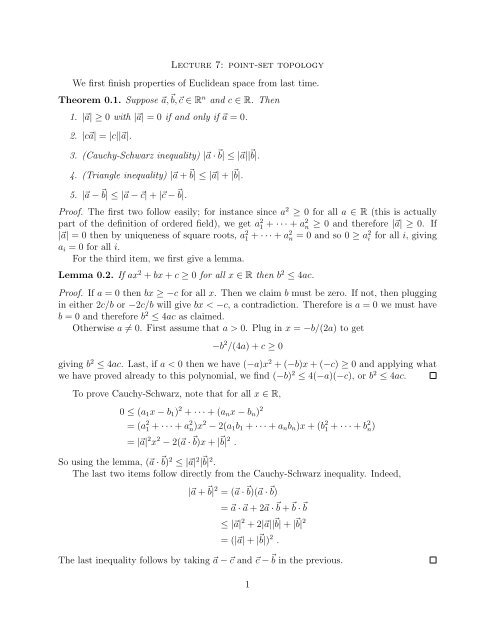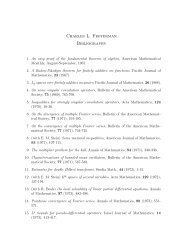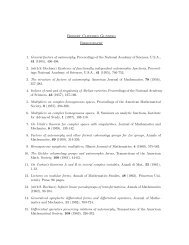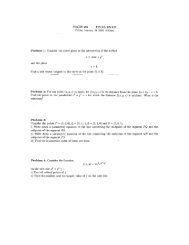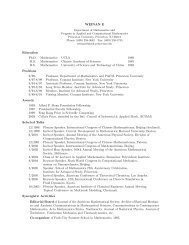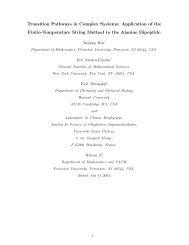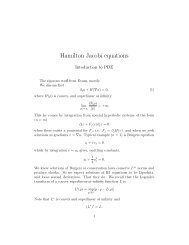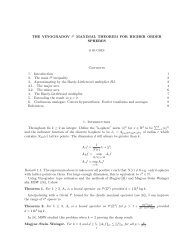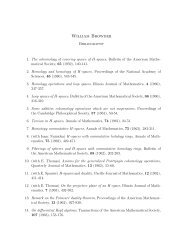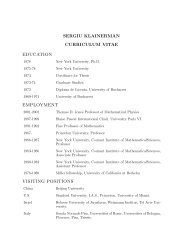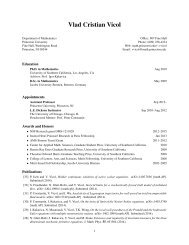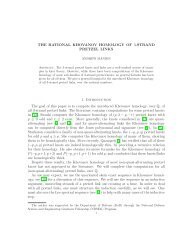Lecture 7: point-set topology We first finish properties of Euclidean ...
Lecture 7: point-set topology We first finish properties of Euclidean ...
Lecture 7: point-set topology We first finish properties of Euclidean ...
Create successful ePaper yourself
Turn your PDF publications into a flip-book with our unique Google optimized e-Paper software.
<strong>Lecture</strong> 7: <strong>point</strong>-<strong>set</strong> <strong>topology</strong><br />
<strong>We</strong> <strong>first</strong> <strong>finish</strong> <strong>properties</strong> <strong>of</strong> <strong>Euclidean</strong> space from last time.<br />
Theorem 0.1. Suppose a, b,c ∈ R n and c ∈ R. Then<br />
1. |a| ≥ 0 with |a| = 0 if and only if a = 0.<br />
2. |ca| = |c||a|.<br />
3. (Cauchy-Schwarz inequality) |a · b| ≤ |a|| b|.<br />
4. (Triangle inequality) |a + b| ≤ |a| + | b|.<br />
5. |a − b| ≤ |a − c| + |c − b|.<br />
Pro<strong>of</strong>. The <strong>first</strong> two follow easily; for instance since a 2 ≥ 0 for all a ∈ R (this is actually<br />
part <strong>of</strong> the definition <strong>of</strong> ordered field), we get a 2 1 + · · · + a 2 n ≥ 0 and therefore |a| ≥ 0. If<br />
|a| = 0 then by uniqueness <strong>of</strong> square roots, a 2 1 + · · · + a 2 n = 0 and so 0 ≥ a 2 i for all i, giving<br />
ai = 0 for all i.<br />
For the third item, we <strong>first</strong> give a lemma.<br />
Lemma 0.2. If ax 2 + bx + c ≥ 0 for all x ∈ R then b 2 ≤ 4ac.<br />
Pro<strong>of</strong>. If a = 0 then bx ≥ −c for all x. Then we claim b must be zero. If not, then plugging<br />
in either 2c/b or −2c/b will give bx < −c, a contradiction. Therefore is a = 0 we must have<br />
b = 0 and therefore b 2 ≤ 4ac as claimed.<br />
Otherwise a = 0. First assume that a > 0. Plug in x = −b/(2a) to get<br />
−b 2 /(4a) + c ≥ 0<br />
giving b 2 ≤ 4ac. Last, if a < 0 then we have (−a)x 2 + (−b)x + (−c) ≥ 0 and applying what<br />
we have proved already to this polynomial, we find (−b) 2 ≤ 4(−a)(−c), or b 2 ≤ 4ac.<br />
To prove Cauchy-Schwarz, note that for all x ∈ R,<br />
0 ≤ (a1x − b1) 2 + · · · + (anx − bn) 2<br />
= (a 2 1 + · · · + a 2 n)x 2 − 2(a1b1 + · · · + anbn)x + (b 2 1 + · · · + b 2 n)<br />
= |a| 2 x 2 − 2(a · b)x + | b| 2 .<br />
So using the lemma, (a · b) 2 ≤ |a| 2 | b| 2 .<br />
The last two items follow directly from the Cauchy-Schwarz inequality. Indeed,<br />
|a + b| 2 = (a · b)(a · b)<br />
= a · a + 2a · b + b · b<br />
≤ |a| 2 + 2|a|| b| + | b| 2<br />
= (|a| + | b|) 2 .<br />
The last inequality follows by taking a − c and c − b in the previous.<br />
1
This leads us to the definition <strong>of</strong> a metric space.<br />
Definition 0.3. A <strong>set</strong> X with a function d : X × X → R is a metric space if for all<br />
x, y, z ∈ X,<br />
1. d(x, y) ≥ 0 and equals 0 if and only if x = y and<br />
2. d(x, y) ≤ d(x, z) + d(z, y).<br />
Then we call d a metric.<br />
A useful example <strong>of</strong> a metric space is R n with metric d(a, b) = |a − b|.<br />
Open and closed <strong>set</strong>s: beginning chapter 2 <strong>of</strong> Rudin<br />
Let (X, d) be a metric space. <strong>We</strong> are interested in the possible sub<strong>set</strong>s <strong>of</strong> X and in what<br />
ways we can describe these using the metric d. Let’s start with the simplest.<br />
Definition 0.4. Let r > 0. The neighborhood <strong>of</strong> radius r centered at x ∈ X is the <strong>set</strong><br />
For example,<br />
Br(x) = {y ∈ X : d(x, y) < r}<br />
1. in R using the metric d(x, y) = |x − y| we have the open interval<br />
Br(x) = (x − r, x + r) = {y ∈ R : x − r < y < x + r} .<br />
2. In R n using the metric d(x, y) = |x − y| we have the open ball<br />
Br(x) = {(y1, . . . , yn) : (x1 − y1) 2 + · · · + (xn − yn) 2 < r 2 } .<br />
To describe that these <strong>set</strong>s appear to be open (that is, no <strong>point</strong> is on the boundary), we<br />
introduce a formal definition <strong>of</strong> open.<br />
Definition 0.5. Let (X, d) be a metric space. A <strong>set</strong> Y ⊂ X is open if for each y ∈ Y there<br />
exists r > 0 such that Br(y) ⊂ Y .<br />
For each <strong>point</strong> y we must be able to fit a (possibly tiny) neighborhood around y so that<br />
it still stays in the <strong>set</strong> Y . Thinking <strong>of</strong> Y as, for example, an open ball in R n , as our <strong>point</strong><br />
y approaches the boundary <strong>of</strong> this <strong>set</strong>, the radius we take for the neighborhood around this<br />
<strong>point</strong> will have to decrease.<br />
2
Proposition 0.6. Any neighborhood is open.<br />
Pro<strong>of</strong>. Let x ∈ X and r > 0. To show that Br(x) is open we must choose y ∈ Br(x) and<br />
show that there exists some s > 0 such that Bs(y) ⊂ Br(x). The radius s will depend on<br />
how close y is to the boundary. Therefore, choose<br />
s = r − d(x, y) .<br />
To show that for this s, we have Bs(y) ⊂ Br(x) we take z ∈ Bs(y). Then<br />
Some more examples:<br />
d(x, z) ≤ d(x, y) + d(y, z) < d(x, y) + s = r .<br />
1. In R, the only intervals that are open are the (surprise!) open intervals. For instance,<br />
let’s consider the half-open interval (0, 1] = {x ∈ R : 0 < x ≤ 1}. If it were open, we<br />
would be able to, given any x ∈ (0, 1], find r > 0 such that Br(x) ⊂ (0, 1]. But clearly<br />
this is false because Br(1) contains 1 + r/2.<br />
2. In R 2 , the <strong>set</strong> {(x, y) : y > 0} ∪ {(x, y) : y < −1} is open.<br />
3. In R 3 , the <strong>set</strong> {(x, y, z) : y > 0} ∪ {(0, 0, 0)} is not open.<br />
Proposition 0.7. Let C be a collection <strong>of</strong> open <strong>set</strong>s.<br />
1. The union <br />
O∈C O is open.<br />
2. If C is finite then <br />
O∈C O is open. This need not be true if the collection is infinite.<br />
Pro<strong>of</strong>. Let x ∈ ∪O∈CO. Then there exists O ∈ C such that x ∈ O. Since O is open, there<br />
exists r > 0 such that Br(x) ⊂ O. This is also a sub<strong>set</strong> <strong>of</strong> ∪O∈CO so this <strong>set</strong> is open.<br />
To show that we cannot allow infinite intersections, consider the <strong>set</strong>s (−1/n, 1/n) in R.<br />
<strong>We</strong> have<br />
∩ ∞ n=1(−1/n, 1 + 1/n) = [0, 1] ,<br />
which is not open (under the usual metric <strong>of</strong> R).<br />
For finite intersections, let O1, . . . , On be the open <strong>set</strong>s from C and x ∈ ∩ n i=1Oi. Then<br />
for each i, we have x ∈ Oi and therefore there exists ri > 0 such that Bri (x) ⊂ Oi. Letting<br />
r = min{r1, . . . , rn}, we have Br(x) ⊂ Bri (x) for all i and therefore Br(x) ⊂ Oi for all i.<br />
This implies Br(x) is a sub<strong>set</strong> <strong>of</strong> the intersection and we are done.<br />
Definition 0.8. An interior <strong>point</strong> <strong>of</strong> Y ⊂ X is a <strong>point</strong> y ∈ Y such that there exists r > 0<br />
with Br(y) ⊂ Y . Write Y ◦ for the <strong>set</strong> <strong>of</strong> interior <strong>point</strong>s <strong>of</strong> Y .<br />
Directly by definition, Y is open if and only if Y = Y ◦ .<br />
3
Examples:<br />
1. The <strong>set</strong> <strong>of</strong> interior <strong>point</strong>s <strong>of</strong> [0, 1] (under the usual metric) is (0, 1).<br />
2. The <strong>set</strong> <strong>of</strong> interior <strong>point</strong>s <strong>of</strong><br />
is just {(x, y) : y > 0}.<br />
3. What is the <strong>set</strong> <strong>of</strong> interior <strong>point</strong>s <strong>of</strong> Q?<br />
{(x, y) : y > 0} ∪ {(x, y) : x = −1, y ≥ 0}<br />
4. Define a metric on R 2 by d(x, y) = 1 if x = y and 0 otherwise. This can be shown to<br />
be a metric. Given a <strong>set</strong> Y ⊂ R 2 , what is Y ◦ ?<br />
Definition 0.9. A <strong>set</strong> Y ⊂ X is closed if its complement X \ Y is open.<br />
Sets can be both open and closed. Consider ∅, whose complement is clearly open, making<br />
∅ closed. It is also open.<br />
Proposition 0.10. Let C be a collection <strong>of</strong> closed <strong>set</strong>s.<br />
1. <br />
C∈C C is closed.<br />
2. If C is finite then <br />
C∈C C is closed.<br />
Pro<strong>of</strong>. Just use X \ [∩C∈CC] = ∪C∈C(X \ C).<br />
There is an alternative characterization <strong>of</strong> closed <strong>set</strong>s in terms <strong>of</strong> limit <strong>point</strong>s<br />
Definition 0.11. Let Y ⊂ X. A <strong>point</strong> x ∈ x is a limit <strong>point</strong> <strong>of</strong> Y if for each r > 0 there<br />
exists y ∈ Y such that y = x and y ∈ Br(x).<br />
Examples:<br />
1. 0 is a limit <strong>point</strong> <strong>of</strong> {1, 1/2, 1/3, . . .}.<br />
2. {1, 2, 3} has no limit <strong>point</strong>s.<br />
3. In R 2 , B1(0) ∪ {(0, y) : y ∈ R ∪ {(10, 10)} has limit <strong>point</strong>s<br />
{(x, y) : x 2 + y 2 ≤ 1} ∪ {(0, y) : y ∈ R} .<br />
4


